Below are summary of Pros and Cons of various material used for Radio control/ FPV/UAV flight platform.
- EPO foam
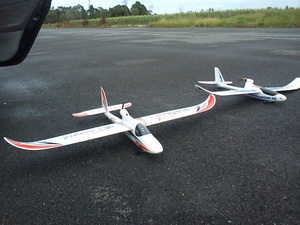 Pros: Very dense, rigid and elastic foam. Resist dents and slight bumps due to elastic property. Most prefered foam for molding detailed scale models. Ideal material for beginners r/c pilot due to robust plane structure after crashes, easily glue back using hot glue if tore apart.
Pros: Very dense, rigid and elastic foam. Resist dents and slight bumps due to elastic property. Most prefered foam for molding detailed scale models. Ideal material for beginners r/c pilot due to robust plane structure after crashes, easily glue back using hot glue if tore apart.- Cons: The bigger the models the heavier it get due to foam density per-size.
- FPV/UAV use: Usually these are number one choice for starter due to robust and tough material attributes. Most popular construction molding material to build glider type platform such as Sky Walker, HK Bixler, Zephyr lines and flying wings which spanned between 1.2~2.2m wingspan. Due to their robust property sometimes ground object and living things may get damaged due to crash impact if the foam exceed their weight ratio.
- Most popular use in brand: FMS, DURAFLY J-Power, Sky Angels, Hobby King gliders, Dynam
- Pilot level requirement/suitability: Beginners
- Crash durability: 8/10 (Very tough)
- Ground/public damage severity: 7/10
- Crash repair: 9/10 (Easy to repair)
- EPP foam
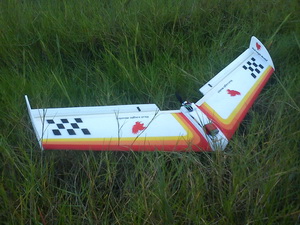 Pros: Dense sponge like foam material usually popular for making profile 3D plane "plank plane". High elastic and flexy property if slices in sheets. Plane construction usually supported using embedded carbon spar/rods to maintain the shape of the wings and plane structure. Tolerant to heavy crashes. Usually popular for small to medium size profile 3D plane for indoor flights.
Pros: Dense sponge like foam material usually popular for making profile 3D plane "plank plane". High elastic and flexy property if slices in sheets. Plane construction usually supported using embedded carbon spar/rods to maintain the shape of the wings and plane structure. Tolerant to heavy crashes. Usually popular for small to medium size profile 3D plane for indoor flights.- Cons: The bigger the models the heavier they get due to foam density. The surface also have lots of micro pockets of holes that causes too much drag with the air. Ideally for slow flyer in a form of flat sheet profile.
- FPV/UAV use: EPP choice mostly popular on flying wing type platform such as Techone Pop wing and HK flying wing. They are favor for being spongy, rubbery rigid and less hazardous during crashes and impact provided they were build in smaller size. They also safe to fly and crashes into any object provided it was build with in less layer density. Very bouncy material but hazardous when it get heavy in built.
- Most popular use in brand: TECHONE, Hobby King 3D profiles
- Pilot level requirement/suitability: Beginner-Intermediate.
- Crash durability: 9/10 (Extremely tough)
- Ground/public damage severity: 3/10
- Crash repair: 10/10 (Easy to repair)
- EPS foam
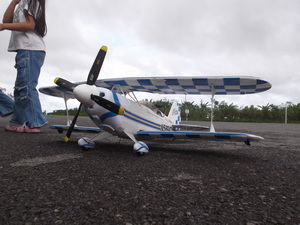 Pros: They are extremely light, rigid and can be molded to any shape very popular for detailed scale models. Usually a secondary choice for construction after EPO foam. They are very floaty and easy to fly airframe due to its lightweight material.
Pros: They are extremely light, rigid and can be molded to any shape very popular for detailed scale models. Usually a secondary choice for construction after EPO foam. They are very floaty and easy to fly airframe due to its lightweight material.- Cons: They are extremely brittle, break like an ice cube upon slight impact leaving perfect broken puzzle like jigs of debris. Easily scratched and dented using finger nail. Usually suitable for experience r/c pilot who opt for their performance flying characteristics.
- FPV/UAV use: EPS foam is not popular in this application because they are not tolerant to crashes and obliterated instantly upon impact with no hope to fix due to immense small of foam puzzle like debris. However they are extremely lightweight and most preferred for those who prefer lightweight performance and crash safety where ground property or living things safety are of main concern. Majority of my flight models i flown are made from EPS.
- Most popular use in brand: Old Art-Tech models, Freewing, LX Jet, SAPAC
- Pilot level requirement/suitability: Advance.
- Crash durability: 2/10
- Ground/public damage severity: 4/10
- Crash repair: 3/10 (Good luck)
- Depron foam
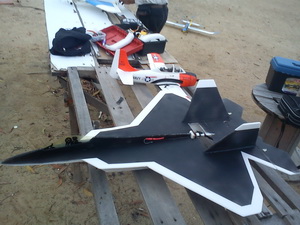 Pros: Made form layered compressed spongy foams and thin layered plastics. Brittle yet lightweight foam sandwiched between thin plastic cover to maintain rigid sheet of planks which popularly sold in stationary shop for model crafting works. They almost looks like in sheet of cardboard like form in white color or sometimes colored on outer surface. This material mostly preferred for DIY plane builder for park flying plane or DIY 3D profile or pusher jet prop type plane.
Pros: Made form layered compressed spongy foams and thin layered plastics. Brittle yet lightweight foam sandwiched between thin plastic cover to maintain rigid sheet of planks which popularly sold in stationary shop for model crafting works. They almost looks like in sheet of cardboard like form in white color or sometimes colored on outer surface. This material mostly preferred for DIY plane builder for park flying plane or DIY 3D profile or pusher jet prop type plane.- Cons: It has all the brittle elements like EPS foam.
- FPV/UAV use: Most favor material for DIY plane build among seasonal FPV home builder. Popular for building flying wing and custom twin tail plane due to lightweight properties.
- Most popular use in brand: TECHONE 3D profile indoor plane (F3P)
- Pilot level requirement/suitability: Intermediate-Advance.
- Crash durability: 3/10
- Ground/public damage severity: 1/10 (Less damage inflicted)
- Crash repair: 7/10 (Ok but not that beautiful)
- Carbon fiber
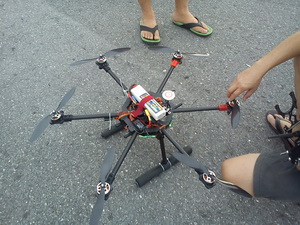 Pros: Extremely rigid, strong and lightweight popular for muti-rotor construction or heavy duty rotor based application.
Pros: Extremely rigid, strong and lightweight popular for muti-rotor construction or heavy duty rotor based application.- Cons: Radio frequency penetration and reflection problem on board radio hardware. Suitable for short range due to this limitation.
- FPV/UAV use: Popular for multi-rotor and helicopter build usually tag along with CNC alloy for lacing and clamping assembly. These material favor for load stress performance carrying heavy payload such as camera, gimbals and other onboard monitoring sensors.
- Most popular use in brand: All muti-rotor brands
- Pilot level requirement/suitability: Beginner-Advance.
- Crash durability: 0/10 (Total lost)
- Ground/public damage severity: 10/10 (Really bad)
- Crash repair: 0/10 (Gone)
- Balsa/Birch plywood
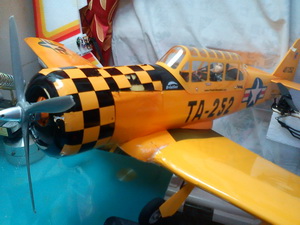 Pros: Lightweight material for constructing skeletal airframe which usually covered with Monokote films. The first and traditional method of building planes similar fashion to building a real plane. They are extremely lightweight compare to EPO foam when build equally bigger size exceed 1.6mm wingspan.
Pros: Lightweight material for constructing skeletal airframe which usually covered with Monokote films. The first and traditional method of building planes similar fashion to building a real plane. They are extremely lightweight compare to EPO foam when build equally bigger size exceed 1.6mm wingspan.- Cons: Extremely brittle, long building duration and required skill to build airframe using this material
- FPV/UAV use: Ideally use for those opt for bigger flying platform powered by fuel/gas powered engines. These platform are easy to fly when compare to foam and has low structural flex giving constant solid handling throughout the flight. The thin wall allow bigger fuselage cavity for FPV/UAV hardware installation. Bigger size balsa platform have excellent flying and floaty capability.
- Most popular use in brand: World Models, Top Flite, Precision Aerobatics
- Pilot level requirement/suitability: Advance.
- Crash durability: 1/10
- Ground/public damage severity: 7/10
- Crash repair: 1/10 (Hard to repair)
- Fiber glass/composite
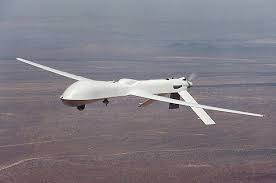 Pros: Strong fiber like egg shell, beautiful shiny finishing, aerodynamics and reduce wind resistances. Mostly use on bigger size flying platform and scale planes where payload consists of heavy hardware, oil/gas driven engine.
Pros: Strong fiber like egg shell, beautiful shiny finishing, aerodynamics and reduce wind resistances. Mostly use on bigger size flying platform and scale planes where payload consists of heavy hardware, oil/gas driven engine.- Cons: Radio frequency penetration and reflection problem on board radio, overall are extremely heavy platform
- FPV/UAV use: Usually can be found use by professional FPV/UAV drone user or companies that prefer bigger plane and could handle larger scale payload for commercial purposes. Require more powerful electric motor or engine to propel this platform.
- Most popular use in brand: HK FPV Raptor, Hobby King big scale models/UAV replicas
- Pilot level requirement/suitability: Advance.
- Crash durability: 4/10
- Ground/public damage severity: 9/10 (Really bad)
- Crash repair: 1/10 (Fiber patch else trash)
Simple Safety Experiment
If you really concern about crash safety and don't want to hurt anyone if it do crash in the future try this safety test, 100% it will works and you don't have to be rocket scientist with expensive test lab to do that.
Safety test :
*(caution this experiment requires high level of "jackasses", we are not responsible for such attempted action.)
- You found a flying model that you like but not sure if this material would hurt people or not during crash...but don't hope for it to happen.
- Get a friend or your best buddy stand beside you for a test.
- Now hold the plane from above your friend or buddy and smack it lightly on his/her fore head. Check if he or she felt the pain or not.
- Repeatedly do step (3) with increase exponential intensity until your friend/buddy felt the pain on forehead. The smack intensity simulate the expected crash speed by gravity force.
- Stop if he or she scream/shout eg: "Ow! that hurts!" or translated into other languages. If foul language detected then its extremely bad platform to crash into public.
- Test success! Now you can end it and decided if you think the model material suits your safety public standard or vice versa.
